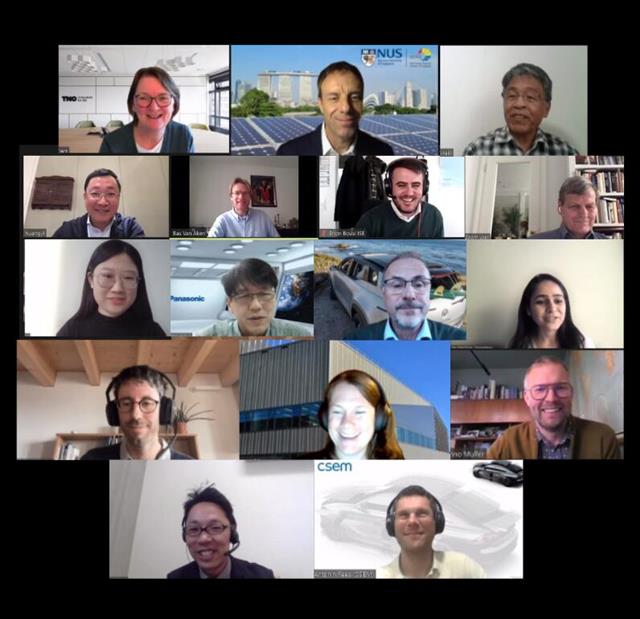
On April 7th, the first day of discussions for the First International Integrated-PV Workshop kicked off online. The two-day event was organized by Forschungszentrum Jülich, Solar Energy Research Institute of Singapore (SERIS) at the National University of Singapore (NUS), Southwest Petroleum University and Sun Yat-sen University.
The workshop has brought together, for the first time, experts in the area of Building-integrated PV (BIPV), Floating PV, Agro-PV, Vehicle-integrated PV (VIPV) and others to discuss the way forward to carbon neutrality and generate synergies between different disciplines.
Integrated PV will be the “New Normal”
To achieve carbon neutrality, the future of our electricity supply will see a massive increase in solar power generation, which will contribute more than 50% of the global electricity generation by 2050.
Dr. Thomas Reindl, Deputy CEO of SERIS, said that the demand for electricity will go up massively as population grows and the world accelerates the electrification process of transport, domestic and industrial sectors.
For the extreme case that we would "electrify everything", an analysis of researchers from the Australian National University (ANU) estimates a total installed capacity of about 80 TWp of solar PV to achieve zero emissions.
“This is roughly equivalent to ~600,000 km2 of space,” Reindl said. For countries with limited land resources, integrated PV like BIPV, Floating PV, VIPV, Agro-PV will be the perfect solution. He highlighted the almost inexhaustible opportunities for Agro-PV and Floating PV in near- and off-shore spaces (Marine PV).
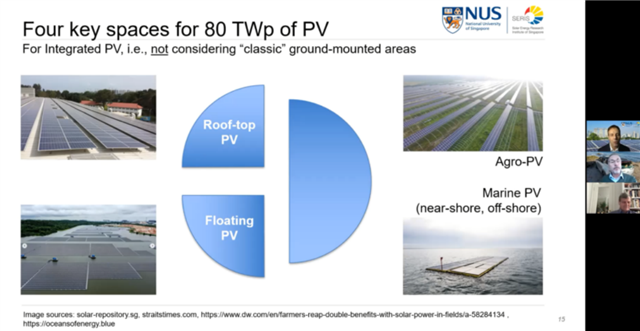
A screenshot of Dr. Thomas Reindl’s presentation
Dr. Eicke R. Weber, Co-Chairman of European Manufacturing Council, said in his presentation that in 2050 or even before, more than 50,000 GWp of PV will need to be installed. However, by 2022, just about the first 1,000 GWp have been installed globally. “The big growth of the PV industry globally is still ahead of us,” said Weber.
He also emphasized the importance of PV integrated in existing infrastructures, for example parking lots. “If we cover all the parking lots worldwide with solar roofs, we already can have the first of the terawatts needed; and the PV systems provide an additional benefit by shading the cars underneath,” he said.
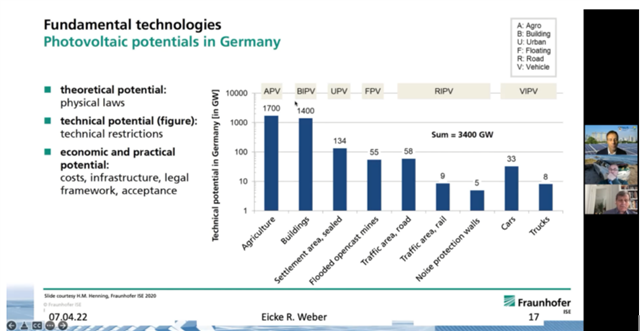
A screenshot of Dr. Eicke R. Weber’s presentation
According to a study at Fraunhofer ISE, the potentials for solar PV are massive just in Germany alone. “We could put 1.7 terawatts in agrivoltaics, 1.4 terawatts in building-integrated PV, and many more. So, these are very substantial numbers,” said Weber.
Dr. Pierre Verlinden, Adjunct Professor at the University of New South Wales, pointed out that for the world to reduce carbon emissions to zero by 2050, about 70 TW of PV will be needed globally, which is about 7 kW of PV per capita by then.
Double-use of land and integrated PV are becoming critical to reach this objective. Verlinden commented that, “if we diversify the application of PV, we need less storage, because the generation will happen at different times, locations and orientations. So, the potential is enormous and particularly Agro-PV and Floating PV will be significant in the next few years.”
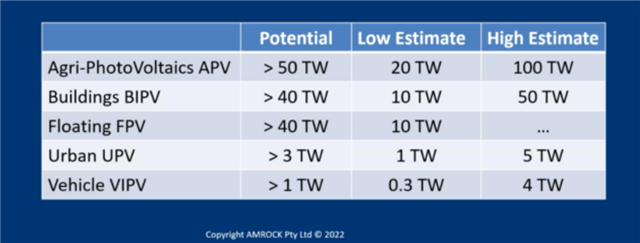
A screenshot of Dr. Pierre Verlinden’s presentation
After the plenary session, experts in VIPV and Agro-PV shared their insights from different perspectives.
Vehicle- integrated PV
Professor Kenji Araki from the University of Miyazaki introduced the differences and similarities between PV for vehicles and standard PV systems. For example, VIPV has significant mismatching loss by partial shading from small shadows like street signs. Irradiance on VIPV is subject to rapid fluctuation that could vary by several ms, compared to several seconds on standard PV. Araki also mentioned the difficulty to measure curved modules that are typically used in VIPV.
Dr. Antonin Faes, Focus Area Manager from Swiss Center for Electronics and Microtechnology (CSEM) elaborated on integrated PV for mobility on road, sea and for stratospheric applications. He further introduced CSEM’s solar mobility solutions with lightweight and highly-efficient PV modules that can be used in different application scenarios.
Dr. Anna Carr, Scientist in PV Module Technology and Applications at Netherlands Organization for Applied Scientific Research (TNO) focused on the technologies and potential of vertically mounted VIPV. If solar modules are installed on car roofs, “Australia and Morocco can reach more than 6,000 solar kilometers a year…so it’s really substantial benefit. Even in cloudy Amsterdam more than 4,000 km/year can be realized, adding solar panels to the sides can provide extra solar kilometers, further reducing the need to charge from the grid,” said Carr.
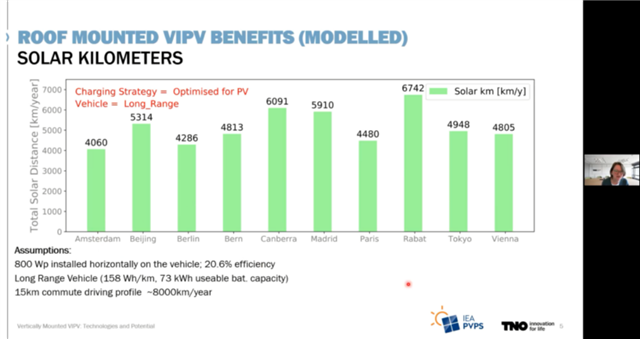
A screenshot of Dr. Anna Carr’s presentation
Taizo Masuda, Project Manager from Toyota Motor Corporation then displayed the progress and prospects of VIPV and efforts at Toyota. He believed that solar-powered vehicle could be the most promising solution to reduce carbon emissions from passenger cars. Based on Toyota’s public road testing with a 860W PV system integrated on a passenger car, “avoid-charging-by-grid” car can be realized.
Agrivoltaics
Dr. Onno Muller is the Head of Field Phenotyping at Forschungszentrum Jülich. As an expert in shoot dynamics and field phenotyping, Muller focuses his presentation on plant phenotyping under agri-horti PV. For the said PV projects, crop yield is a complex trait that varies strongly between the years, Dr. Muller said.
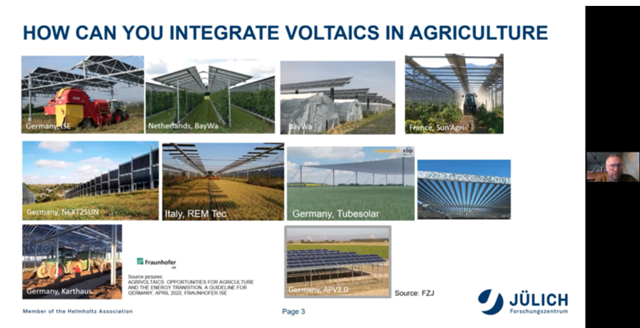
A screenshot of Dr. Onno Muller’s presentation
Dr. Bas Van Aken, a scientist in advanced solar parks and agriculture at TNO Energy Transition, then talked about ways to balance energy and food production in agrivoltaics systems. He suggested that more knowledge and expertise are needed to understand the response of crops to reduced light and the effect of alternately sunlight or hard shadow on crops. This is needed to find the right combination of crop, climate, solar park design and local conditions.
Following Dr. Van Aken, Dr. Gaël Nardin, the R&D Manager at Insolight introduced a semi-transparent solution for dynamic agrivoltaics. He believed that agrivoltaics could combine agriculture and solar energy without trade-offs. Compared with conventional solar panels that suffer limitations, like too much shade which could result in dramatic agricultural yield loss, Insolight’s semi-transparent dynamic solution can both protect crops and ensure high electricity generation, according to Nardin.
Mr. Erion Bousi, Research Assistant at Fraunhofer ISE focused on the modeling and design of orchard agrivoltaics. In this scenario, modules can offer as substitutes of hail nets and plastic foils for crop production against severe weather events. Bousi found out in his research that increased module transparency can lead to improved light availability and homogeneity. At the same time the increase of transparency affect negatively the techno-economic performance of the PV side.
At the end, Professor Yuelong Huang, the Dean of the Institute of Photovoltaics at Southwest Petroleum University closed the sessions on day one. He said that, “it is our great honor to co-organize this workshop with Forschungszentrum Jülich, SERIS and Sun Yat-sen University.” And from the talks on different topics, “we’re able to find out the great potential of integrated PV applications on cars, buses, boats, trains and other vehicles.”
Click to read: Floating PV, BIPV hold great promise and great challenges- IPV Day 2


